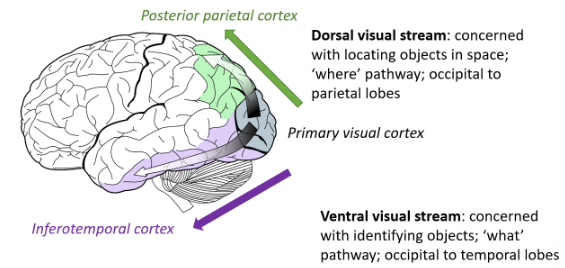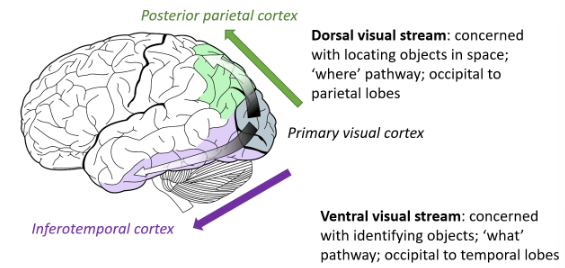L17: Faces
1/32
There's no tags or description
Looks like no tags are added yet.
Name | Mastery | Learn | Test | Matching | Spaced |
|---|
No study sessions yet.
33 Terms
Case study P.S.
Had prosopagnosia (couldn’t recognise races, even her own)
Damage to what part of the brain presents prosopagnosia
Fusiform face area
Region specific to processing faces
In the inferior temporal lobes and fusiform gyrus
Bruce & Young: Cognitive model of face processing
How they thought we extract information from faces
Two pathways:
Expression information
Identity information (i.e. who is that person)
Two pathways suggested from prosopagnosia research
Prosopagnosic deficit located at face recognition unit stage
Prosopagnosia
Damage to occipitotemporal cortex (acquired prosopagnosia)
Unable to recognise familiar faces
No impairments in identity of familiar people
Use other cues i.e. voice, name
Ability to recognise and name other objects is spared
Ventral visual stream
Concerned with identifying objects
‘What’ pathway
Occipital to temporal lobes
Information travels along the posterior parietal cortex

Dorsal visual stream
Concerned with locating objects in space
‘Where’ pathway
Occipital to parietal lobes
Information travels along the inferotemporal cortex

What stream is largely concerned with face perception
Ventral visual stream
What are the three main face-sensitive areas in the brain
Occipital Face Area (OFA)
Fusiform Face Area (FFA)
Invariant aspects of faces (i.e. identity)
Superior temporal sulus (STS)
Responds to face and bodies
Dynamic stimuli, changeable aspects of faces (e.g. expression)
Where is the Occipital Face Area (OFA) located
Inferior occipital gyrus
OFA role in facial recognition
Early stage of face perception (occipital lobe)
Sends input to fusiform and superior temporal regions
Defined by greater response to faces than non-face categories
Responds to upright and inverted faces
Sensitive to physical changes in stimulus
FFA (fusiform face area) role in facial recognition
Greater response to face vs. other non-face categories
Responds more to upright faces
Sensitive to changes in identity, relatively insensitive to physical changes
Acquired prosopagnosia usually due to lesions in or around FFA
Where is the FFA located
Fusiform gyrus
What study shows us the OFA is sensitive to physical changes vs the FFA being sensitive to identity changes
Rotschtein et al (2005)
Use face adaptation
Greater signal change in OFA when physical properties were changed
Visa versa for FFA
Where is the STS (superior temporal sulcus) located
Superior temporal sulcus
STS (superior temporal sulcus) role in facial recognition
Responds to faces, BUT also other stimuli like bodies, eye gaze, etc.
Changeable aspects of faces (viewpoint, gaze direction, expression), but not identity
Responds to moving bodies and to changes in gaze direction
Haxby, Hoffmann & Gobbini (2000): Neural Model for Face Perception
‘Replace’ Bruce and Young’s cognitive model
Distributed neural system for face perception
Proposed separate pathways for processing expression and identity
What pathway did Haxby, Hoffmann & Gobbini (2000) argue we extracted identity information
OFA (inferior occipital) to the FFA (temporal lobes)
What pathway did Haxby, Hoffmann & Gobbini (2000) argue we extracted identity information
OFA to the STS
What is the question of FFA being expertise of specificity referring to?
Are faces special (specificity) OR is the reason we have areas of the brain dedicated to faces is because we are exposed to them so frequently (expertise)
Domain-general (expertise) vs. Domain-specific (face specificity)
What is the hypothesis that FFA expertise follows?
Expertise hypothesis argues that face-specific mechanisms are highly specialised for distinguishing between exemplars of a category
If you had similar expertise in a non-face category, then same processing mechanisms would be engaged
What is the hypothesis that FFA face-specificity follows?
Kanwishes
Face-specificity hypothesis argues that face perception is a process occurring in dedicated, specialized cognitive and neural mechanisms
Evidence for face-specificity hypothesis in FFA
FFA responds more to faces than non-face categories
Activation to faces is more consistent and much more robust than dace selective activity in OFA and STS (other face areas)
HOWEVER, on their own, neither of these conclusively provide evidence that FFA activation to faces supports face specificity hypothesis
Study that tested FFA expertise: Greebles
Gauthier et al. (1999): FFA sensitive to expert within-category visual discrimination
Trained P’s to distinguish between greebles
Results
Found increased response in FFA to upright vs inverted greebles in fusiform area
Suggests some sort of holistic processing (hallmark of face perception)
Proof as Greebels NOT facial perception BUT object perception
Real-world expertise: Gauthier et al. (2000)
Group of P’s that were bird watchers OR car experts
Results
Highest response in FFA to faces
BUT in bird experts, see increased FFA activity compared to car experts when looking at birds
HOWEVER, not significant difference for cars and car expert
Counterevidence for FFA expertise hypothesis
Case study R.M: Sergent & Signoret (1992)
Prosopagnosic
Unable to identify himself or his wife
Collected over 5000 miniature cars
No problem in discriminating his cars
THEREFORE, fusiform cant be ONLY region important in facial recognition
Summary
No neuropsychological cases where facial recognition AND objects of expertise have BOTH been impaires, while recognition of nonexpert objects is spares (or visa versa)
Evidence against Kanwishes argument that the FFA is only important for face processing
Ventral stream also important for object processing
Haxby et al argued role in object recognition is also important
Distribution of responses may contain critical information for discriminating between objects
Patterns of activity important, not just one is higher one is lower
Why is object recognition in the fusiform (FFA) area unlikely to be crucially important
Prosopagnosia and visual agnosia
P’s with prosopagnosia can have damage to fusiform area but object recognition remain intact
Visual agnosia (unable to recognise object categories) but not prosopagnosia
Would expect some crossover if objection perception was important in the fusiform area
What was the conclusion reached when Calder & Young (2005) revisited both the cognitive and neural model of face perception
Both models argued for early separation of pathways for changeable (i.e. expression) and unchangeable (i.e. identity) aspects
On revision, Calder & Young (2005) concluded this could NOT happen so early
What evidence did Calder and Young (2005) use to conclude there couldn’t be such a clear separation between identity and expression so early on
If processes are separate, should see double dissociation for identity and expression
Don’t see this
How can emotional response to neutral familiar faces be measured - automatic and conscious
Skin conductance response (SCR)
Familiar faces elicit greater SCR than unfamiliar faces
SCR response to familiar faces with prosopagnosic individuals
P’s with prosopagnosia also show increased SCR to familiar faces
Suggests two pathways to face recognion, one conscious (impaired in prosopagnosia) and one unconscious
What is the capgras delusion
Believe familiar people have been replaced by an imposter
SCR response to familiar faces with capgras delusion individuals
No increased SCR for familiar faces (no emotional response)
More evidence for dissociation between emotional response to faces and face recognition
BUT P’s with ventromedial frontal lobe damage have no SCR to familiar faces, and no Capgras delusion